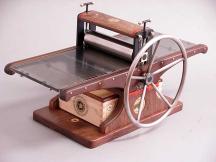
|
es100115 Printmaking ObjectsHow many objects are there?Seeking a way to teach printmaking online, this professor arrives at the question most beginning printmakers encounter: What are the tools and equipment needed for making traditional fine art prints? He uses a musician’s computer game as an idea to teach. Read 441 Wordses100125 Closet MusicianLet the music be heard in a printmaking worldHe postulated there is a connection between printmaking and music. In printmaking you make plates and print them repeatedly. In music you write the score, or improvise, and do this over and over. A good game needs music, and he finds an idea how to do it. Read 791 Wordses100204 Gone Away IIThe sequelAt a beach town in Oregon the artist thinks back to an early impression of what a 19th Century painter, Henri Matisse, said about painting, that a good painting is like an easy chair for the tired business man to come home to for relaxation. He disagrees. 690 Wordses100405 Time WasWhen students paid a lot to hear meIn a nostalgic mood, the old professor reflects on a time when he was at the peak of his career when students paid a high price to hear and see him teaching. Considering this, what do students get today for their money, paying a lot more for someone else? 1286 Wordses100505 Key Concepts of Ritchie MinedA dummies reviewReading “Trading Card Games for Dummies,” the author extracts some concepts for publishing, as a Kindle book, abstracts of his journals and musings. He’s envisioning a game form of collectibles: three-thousand essays and four-hundred Artist Trading Cards. 1367 Wordses100525 Domain CardAnatomy of a basic ATC card in Printmaking CampThe four cornerstones in the hybrid learning printmaking online game are Teaching, Practice, Research and Service, and the Domain Cards can be used in all four. The inventor shows the anatomy of a Domain card in this essay, which includes an illustration. 900 Wordses100624 Dusty in TroubleNotes on a characterThe author is on a team working on a multimedia project, and he’s challenged to write an explanation for the trouble pitted against one of the characters in the back story. The character is a retired art professor who got himself trapped in velvet prison. 962 Wordses100724 Silitransfer and About Edition NumbersPrintmaking workshop and the importance of edition numbersThe author writes about his vision of a printmaking workshop in which he plans to teach intaglio printmaking with his silitransfer method. He also writes about his view of the history, the purpose and the invention of edition numbers for printed artworks. 754 Wordses100802 Moment NumbersWhat about edition numbers?In email I got a message from someone asking the question, “What about edition numbers?” which gave me an opportunity to explain my idea for a better way to document and qualify original handmade prints. “Qualify” in this sense, takes on a double meaning. 724 Wordses100922 Method of PlayHow ‘Zines work in the gameThe author writes about creating ‘Zine index numbers and the rules that apply. The purpose of the ‘Zines is to draw from the unique backgrounds and perspectives of an individual teacher. He also writes his justification for a spectrum of ‘Zines and games. 896 Wordses101216 Defining Gamification of Art EducationUsing game strategies for TRPSArt education is less than a hundred years old in the fields of formal education. Today it is a mature professional field, taught in colleges and universities throughout the USA. It seems to be stagnating when it should be renewing itself technologically. 600 Wordses101226 EquipoiseReflectionsYou wonder if it’s a good idea or a bad idea to reflect on the past and review what people are doing today differently from what you are doing now. You wonder what you are doing! Is the world so small, or is the world truly very large? It makes you think. 362 Words |



Zine Archives |

2014 |
2013 |
2012 |
2011 |
2010 |
2009 |
2008 |
2007 |
2006 |
2005 |
2004 |
2003 |
2002 |
2001 |
2000 |
1999 |
1998 |
1997 |
1996 |
1995 |
1994 |
1993 |
1992 |
1991 |
1990 |
1989 |
1988 |
1987 |
1986 |
1985 |
1984 |
1983 |
1982 |
1981 |
1980 |
1979 |
1978 |
1977 |
1976 |
1975 |
1974 |
1973 |
1972 |
1971 |
1970 |
1969 |
1968 |
1967 |
1966 |
1965 |
1964 |
1963 |
1962 |
1961 |
1960 |
1959 |